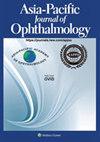基于人口的乌拉尔眼科研究中儿童、成人和老年人角膜炎的患病率和相关性。
IF 4.5
3区 医学
Q1 OPHTHALMOLOGY
引用次数: 0
摘要
目的:估算俄罗斯从儿童到老年人口中角膜炎的患病率及其相关性:研究对象包括在俄罗斯巴什科尔托斯坦州同一地理区域的城市和农村地区进行的 3 项人口研究的队列:乌拉尔儿童眼科研究(UCES;年龄 = 6-18 岁;n = 4890)、乌拉尔眼科和医学研究(UEMS;年龄 = >40 岁;n = 5314)以及乌拉尔高龄研究(UVOS;年龄 = >85 岁;n = 651)。根据 Scheimflug 成像,任何一只眼的角膜度数≥48 斜度 (D) 即为角膜炎:从 UCES(分别为 43.58 ± 1.50 D 和 42.70 ± 1.42 D)到 UEMS(分别为 44.26 ± 1.70 D 和 43.61 ± 1.76 D)再到 UVOS(分别为 45.1 ± 1.72 D 和 43.98 ± 1.68 D),平均最大角膜屈光力和最小角膜屈光力均有所增加。相应地,角膜炎患病率从 UCES(42/4890;0.086%;95% CI = 0.060,0.112)上升到 UEMS(112/5314;2.11%;95% CI = 1.72,2.49)和 UVOS(42/651;6.45%;95% CI = 4.56,8.34)。在 UCES 中,较高的角膜病患病率与较高的出生顺序 [odds ratio (OR) = 2.34; 95% CI = 1.32, 4.15; P = 0.004]、较低的出生体重 (OR = 0.99; 95% CI = 0.99, 0.99; P < 0.001) 和较短的轴长 (OR = 0.15; 95% CI = 0.08, 0.30; P < 0.001) 相关(多变量分析)。在 UEMS 中,角膜炎患病率与较短的轴长(OR = 0.15;95% CI = 0.10,0.23;P < 0.001)、较大的角膜体积(OR = 1.17;95% CI = 1.09,1.25;P = 0.001)、较厚的晶状体(OR = 2.27; 95% CI = 1.06, 5.28; P = 0.04)、皮质白内障程度(OR = 1.02; 95% CI = 1.01, 1.04; P = 0.01)、年龄相关性黄斑变性阶段更高(OR = 1.65; 95% CI = 1.09, 2.51; P = 0.02)。在 UVOS 中,角膜炎患病率与较低的教育水平(OR = 0.84;95% CI = 0.71,0.99;P = 0.04)和较低的动态手握力(OR = 0.92;95% CI = 0.88,0.97;P = 0.003)相关:在这项针对俄罗斯多民族群体的研究中,角膜炎发病率从儿童组(0.09%)上升到成人组(2.11%)和老年组(6.45%),主要与眼部生物计量参数相关,并且在所有年龄组中,在统计学上与大多数系统参数无关。本文章由计算机程序翻译,如有差异,请以英文原文为准。
Prevalence and Associations of Keratoconus Among Children, Adults, and Elderly in the Population-Based Ural Eye Studies
Purpose:
To estimate prevalence and associations of keratoconus in populations in Russia with an age from childhood to seniority.
Methods:
The study population consisted of the cohorts of 3 population-based studies performed in urban and rural areas within the same geographical region in Bashkortostan/Russia: the Ural Children Eye Study (UCES; age = 6–18 y; n = 4890), the Ural Eye and Medical Study (UEMS; age = >40 y; n = 5314), and the Ural Very Old Study (UVOS; age = >85 y; n = 651). Based on Scheimflug imaging, keratoconus was defined by a keratometric reading of ≥48 diopters (D) in any eye.
Results:
The mean maximal and minimal corneal refractive power increased from the UCES (43.58 ± 1.50 D and 42.70 ± 1.42 D, respectively) to the UEMS (44.26 ± 1.70 D and 43.61 ± 1.76 D, respectively) and to the UVOS (45.1 ± 1.72 D and 43.98 ± 1.68 D, respectively). Correspondingly, keratoconus prevalence increased from the UCES (42/4890; 0.086%; 95% CI = 0.060, 0.112) to the UEMS (112/5314; 2.11%; 95% CI = 1.72, 2.49) and to the UVOS (42/651; 6.45%; 95% CI = 4.56, 8.34). In the UCES, higher keratoconus prevalence was associated (multivariable analysis) with higher birth order [odds ratio (OR) = 2.34; 95% CI = 1.32, 4.15; P = 0.004], lower birth weight (OR = 0.99; 95% CI = 0.99, 0.99; P < 0.001), and shorter axial length (OR = 0.15; 95% CI = 0.08, 0.30; P < 0.001). In the UEMS, keratoconus prevalence correlated with shorter axial length (OR = 0.15; 95% CI = 0.10, 0.23; P < 0.001), larger corneal volume (OR = 1.17; 95% CI = 1.09, 1.25; P = 0.001), thicker lens (OR = 2.27; 95% CI = 1.06, 5.28; P = 0.04), cortical cataract degree (OR = 1.02; 95% CI = 1.01, 1.04; P = 0.01), and higher stage of age-related macular degeneration (OR = 1.65; 95% CI = 1.09, 2.51; P = 0.02). In the UVOS, keratoconus prevalence correlated with lower educational level (OR = 0.84; 95% CI = 0.71, 0.99; P = 0.04) and lower dynamometric handgrip force (OR = 0.92; 95% CI = 0.88, 0.97; P = 0.003).
Conclusions:
In this study on multiethnic groups from Russia, keratoconus prevalence increased from the pediatric group (0.09%) to the adult group (2.11%) and seniority group (6.45%), correlated mostly with biometric ocular parameters and was in all age groups statistically independent of most systemic parameters.
求助全文
通过发布文献求助,成功后即可免费获取论文全文。
去求助
来源期刊

Asia-Pacific Journal of Ophthalmology
OPHTHALMOLOGY-
CiteScore
8.10
自引率
18.20%
发文量
197
审稿时长
6 weeks
期刊介绍:
The Asia-Pacific Journal of Ophthalmology, a bimonthly, peer-reviewed online scientific publication, is an official publication of the Asia-Pacific Academy of Ophthalmology (APAO), a supranational organization which is committed to research, training, learning, publication and knowledge and skill transfers in ophthalmology and visual sciences. The Asia-Pacific Journal of Ophthalmology welcomes review articles on currently hot topics, original, previously unpublished manuscripts describing clinical investigations, clinical observations and clinically relevant laboratory investigations, as well as .perspectives containing personal viewpoints on topics with broad interests. Editorials are published by invitation only. Case reports are generally not considered. The Asia-Pacific Journal of Ophthalmology covers 16 subspecialties and is freely circulated among individual members of the APAO’s member societies, which amounts to a potential readership of over 50,000.
 求助内容:
求助内容: 应助结果提醒方式:
应助结果提醒方式:


